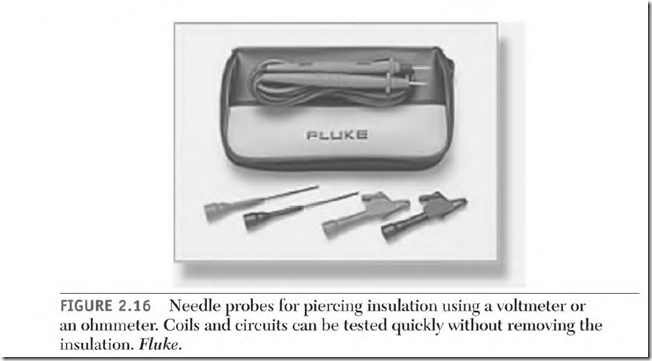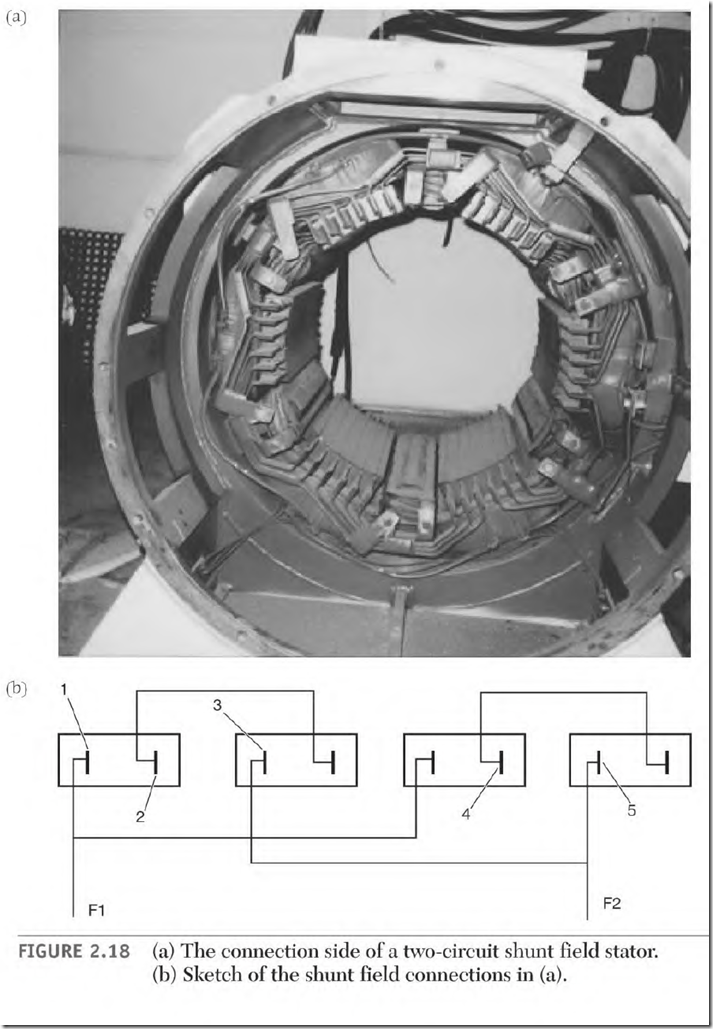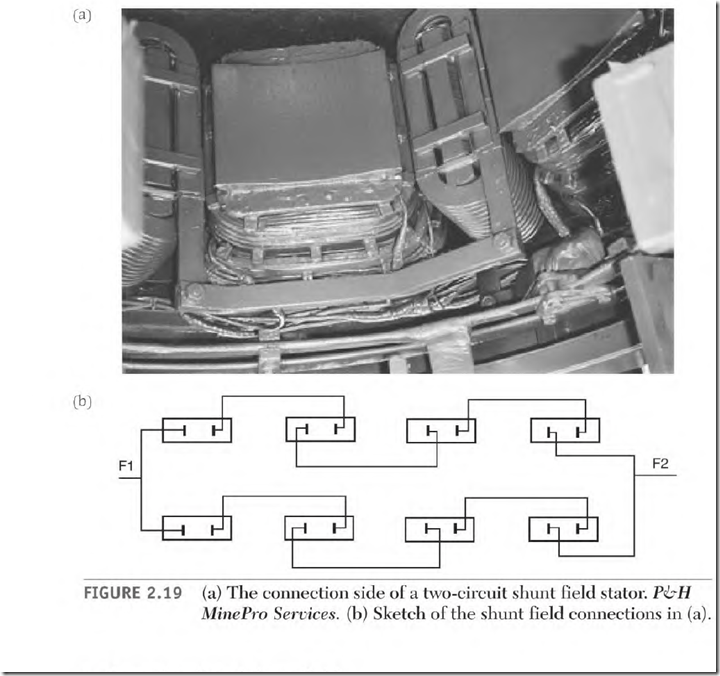The following troubleshooting strategy is applicable to both the shunt machine and the shunt winding of a compound machine.
The Comparison Test
The best method for testing the shunt field (Fl and F2) is to compare one coil’s test data to another coil’s test data. There’s little chance that all the coils would have the same number of turns shorted.
Exception: If all the coils give the same test results and the amperes are too high or too low the winding data may have been redesigned to operate on a different voltage. This is sometimes done when the shunt field is separately excited.
Needle Probes
If the test instruments are a standard ohmmeter or a voltmeter, a sharp needle probe may be used to puncture the insulation covering a coil-to-coil connection (Fig. 2.16). Neither instrument will cause a high enough ampere flow to damage the small probes. If no problem is found, the puncture can be varnished or wrapped with tape.
Variations in the Shunt Field Circuitry
It’s important to understand the shunt field’s internal connection before testing it:
![]() All coils being tested must be alike.
All coils being tested must be alike.
![]() There may be more than one circuit in the shunt field.
There may be more than one circuit in the shunt field.
![]() Some machines have more than one shunt field coil per pole.
Some machines have more than one shunt field coil per pole.
Drawing Simple Schematics of a Shunt Field
Figure 2.17a is a DC shunt machine and Fig. 2.17b is a simplified drawing of this machine’s connection. (It’s a one-circuit shunt field.) The arrows in Fig.
2.17b show where the test probes should contact the connections.
Drawing a Diagram of a Two-Circuit Shunt Field
Figure 2.18a is an example of a two-circuit shunt machine. Figure 2.18b is a simplified drawing of this machine’s connection. (It is a two-circuit shunt
Drawing a Diagram of a Two-Circuit,
Two-Coils-per-Pole Shunt Field
Figure 2.19a is an example of a two-circuit, two-coils-per-pole shunt machine. Figure 2.19b is a simplified drawing of this machine’s connection. Each circuit has four coils in series. Problems in the shunt field are
• Ground to the frame
• Shorted turns
• Open circuit and shunt field
• Shorted to the series field
Ground to the Frame Symptom
Frequent ball bearing failure.
Ground to Frame Symptoms When More Than One Coil Is Shorted to the Frame
• Higher than nameplate amperes in the shunt field
• Some shunt field coils get hotter than others
• Arcing at some brushes
• A motor will lose power and overspeed (with no load)
• A generator won’t develop full voltage and power output
Locating a Grounded Shunt Field Coil Using an Ohmmeter
Separate Fl and F2 from the other leads. Check the resistance of the shunt field with an ohmmeter. A value 25 percent less than the shunt field-rated resistance indicates more than one coil is grounded—or there are shorted turns.
Secure one probe of the ohmmeter to the frame of the motor, making good electrical contact. Touch Fl with the other probe.
No problem will read near infinity. A reading less than the shunt field’s total resistance indicates a grounded coil. A very low reading means the ground is close to the lead being touched. A reading close to the resistance of the shunt field indicates the ground is near the other lead.
Remove the insulation from the coil-to-coil connections, and test each coil to the frame. The coil with the least resistance to the frame will contain the ground. Disconnect this coil and verify that it contains the ground. Test the rest of the shunt field coils for a ground.
When two coils short to the frame, at least one coil will be bypassed. The result is high amperes, and all but the bypassed coils will get hot.
The coils should be tight on the pole iron. If not, move them with the ohmmeter attached to the frame and Fl.
Shunt field coils are wrapped with insulation and are very well insulated from the frame. Brush dust cannot penetrate this insulation. If the lead-toframe reading is less than 50 megohms, the coils are probably damp and should be cleaned, heated, and dried out.
If there is dampness, check the coil in the lowest location. Disconnect the bottom coil to determine if that is causing the low reading. If cleaning and drying do not produce a near-infinity reading, replace the coil. (A single grounded coil is one of the few cases in which replacing only one coil is recommended.)
DC machines should not have an equipment ground. The bare copper bars of the commutator (combined with highly conductive brush dust) make a high-leakage circuit. If a shunt field coil has a ground, the leakage current will go through the bearings to the commutator, resulting in frequent bearing failure and commutator damage.



